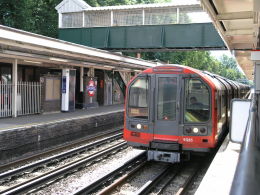Posted 1st August 2012 | 3 Comments
Union urges investigation of Underground fault

THE RMT is calling for an investigation into the cause of a major failure on the London Underground Central Line, in which a wheel became allegedly welded to the track after a brake failure.
It is one of several Underground problems which have occurred in the last two days. There is no service on the District Line this morning (Wednesday) west of Earls Court because of a signal failure at Turnham Green. It is the second problem to disrupt the District this week.
The incident on the Central Line early yesterday caused the eastern section of the line, which is a key Olympics route, to be closed for about two hours.
It was reported that the driver saw smoke in the tunnel at Leyton and noticed a smell of burning. The union said 'the delay in clearing the blockage would be consistent with the brakes failing and welding together – a potential impact from maintenance cuts that RMT has been warning of for over two years'.
RMT general secretary Bob Crowe said: "All of the reports received so far are consistent with a brake failure leading to a fire hazard and the welding tight of over-heated parts. It is down to LUL to now confirm the cause of this major breakdown and disruption, and RMT safety reps will be playing a full role.
“RMT has warned for over two years about the impact of fleet maintenance cuts and specifically brake inspections and the doubling of schedules from 14 to 28 days. We have even released pictures of worn parts from the trains and LUL and the Mayor have not only ignored us but dismissed it as 'scaremongering'.”
London Underground attributed the breakdown to a 'technical fault' in which an axle had become locked. However, the reports of 'welding' have yet to be confirmed.
It has also emerged that there was disruption on one branch of the District Line the night before, when services were interrupted on the Wimbledon line after problems at Putney Bridge. Spectators leaving an Olympics tennis event at Wimbledon were diverted to National Rail and the Northern Line, and also trams and buses.
Transport for London has prepared numerous contingency plans. These depend on the density of transport routes in London which can be used to divert passengers when problems occur.
Reader Comments:
Views expressed in submitted comments are that of the author, and not necessarily shared by Railnews.

Tony Pearce, Reading
New technology means less maintenance. It happened in the Aircraft Industry where Computers are monitoring the aircrafts performance and problems constantly - so theres no need for human inspection on a routine basis. Your family car is the same with the Management System reporting of any problem on your dashboard immediately sometimes cutting in with a 'limp-home' reduction in your speed to avoid any damage.
anonymous, Luton
What utter rubbish. "Smoke in the tunnel at Leyton" - this area is in the open....."brakes failing and welding together" - I've never heard of anything like this..... "wheel welding to the track after a brake failure" - more nonsense. One might ask why you regurgutate these scare mongering press releases!
anonymous, Midlands
Yes again, the RMT scaremongering. Of course, the train operators and infrasturcture owners never look at the causes of failures. Think we are all impressed by the diagnosis by Mr Crow and precise allocation of blame based on pure facts...
The public are fed up of unions like the RMT. Your "efforts" divert funds from real safety and give the public a poor image of rail. You do us all down.